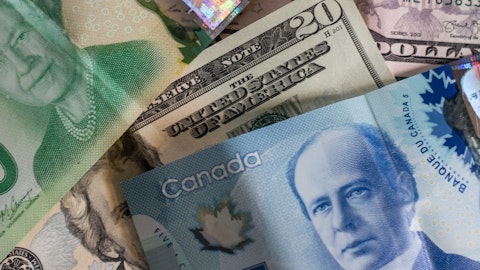Matt Olney: How much is in that we sold in that product?
David Zalman: $1.5 billion.
Matt Olney: I think its $1.5 billion.
Asylbek Osmonov: $1.5 billion.
Matt Olney: $1.5 billion, $1.7 billion, something like that, yes.
David Zalman: Yes.
Asylbek Osmonov: And we don’t have hardly any CDs that go beyond two years.
David Zalman: Well, our total CDs are what right now? I doubt that they’re under 10% of our…
Asylbek Osmonov: Its about 12%, higher than 10%. But that only grows or we see that is in that seven-month special program, and they’re just renewing it.
David Zalman: But over time, if rates stay higher, I think you will see the percentage of CDs to other deposits continue to grow. I remember before rates went to zero, it wasn’t uncommon for a bank like us to have 20% or 30% of their money in certificates of deposits. So, over time, I think you could see that change for sure.
Asylbek Osmonov: Yes, Matt, I did confirm it’s $1.5 billion on the seven-month specialty, right.
Matt Olney: Okay. Thanks for that. And then on the $4 billion borrowing position. Any color on the duration here? I assume most if not all these are eligible to be paid down in the near-term.
Asylbek Osmonov: Yes, essentially, we have a $3 billion from the Fed that we can pay off anytime and rest of them with FHLB overnight pretty much. So all $4 billion can be paid off in a day if we need to.
Matt Olney: Okay. Perfect. And then on those cash flows, you mentioned Asylbek the $2.1 billion that you expect over the next 12 months. Any color or commentary you can give us as far as the yields on those maturities?
David Zalman: 2%.
Asylbek Osmonov: Yes, exactly. It’s exactly pretty much the same with our portfolio shows around 2%.
Matt Olney: Okay. Got it. Okay. That’s all from me. Thanks, guys.
Operator: The next question comes from Jon Arfstrom with RBC Capital Markets. Please go ahead.
Jon Arfstrom: Thanks. I hope I’m last. Hope I’m the last one.
David Zalman: We had heard from you for a while. We thought you quite loving us.
Jon Arfstrom: There are no. There’s love, David, 20-year love. Just – yes, real quick, the $10 billion – little over $10 billion in noninterest-bearing deposits, do you feel like is that a floor? Is it over in terms of the noninterest-bearing outflows?
David Zalman: Anybody would like to say yes, that it is, but we really don’t know that. I think that if interest rates stay high, when I see money moving normally, you would think it’s because our money market rate, we’re paying about 3% that’s if you have over, what $1 million in it or something, or $100,000…
Jon Arfstrom: For the 50% $500,000…
David Zalman: $500,000, okay, so you would think that maybe that’s where the money would be leaving from to go to buying these treasuries now. But when I really look at it, we have another not only the $10 billion that we have in noninterest-bearing, we have another how much in interest bearing checking is paying 2015 or 25 basis points a huge amount of money. But those are the two categories that I actually see go. People are – they are just starting to work their money more. So I guess the answer to the question is in and by itself, I think you probably will see, we will see money come out of those accounts buying either higher rate CDs or going to buy treasuries at the same time. Hopefully, our bank historically Jon has grown the bank 2% to 4% a year organically in deposits.
And of course, you hadn’t seen that at all. So I’m hoping this is just a gut feel, is that we will start maybe at some point we’ll turn around and start building that bank again to offset what’s really going out. But people – the bottom line, people are working their money. This is an interesting because I asked Asylbek to look into it. Our bank historically, before you had all the helicopter money drop, we would grow the bank 2% to 4% organically every year on deposit side. And then of course, you had 10% and 20% gains with helicopter money. But Asylbek went back and took all the money that we’ve lost and taken out the money that came from the acquisition of First Capital. And believe it or not today, if you would have never had the helicopter money, we’re kind of about in the same place.
We’re still grown about 2% to 4%.
Asylbek Osmonov: Yes.
David Zalman: So whether it looks like a lot of the money has left the bank, if you wouldn’t had it to begin with all the helicopter money, we’re probably right where we would have been to begin with. I know that’s getting kind of esoteric, but we really wanted to look at that. So I think what – so I think the future is we’ll still get back to that other category too. You will see banks in the future start going deposits again organically, I think at some point in time.
Jon Arfstrom: Okay. Just two more random ones. FTEs were up 140 employees. And I normally wouldn’t ask about it, but that’s more than normal. Is that acquisition word or what’s driving that?
Asylbek Osmonov: Yes. I think because acquisition had an impact on it, because FDA kind of on average, so that’s had three months of people from the FCB acquisition that’s impacting.


